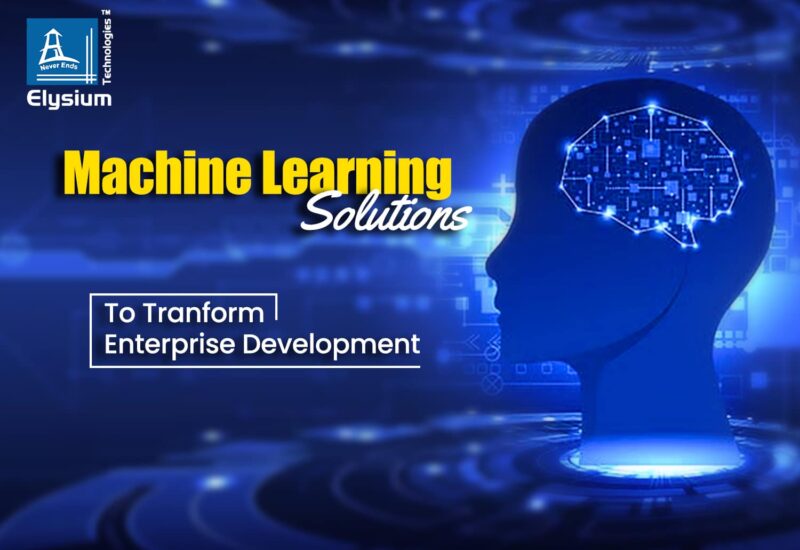Machine Learning Solutions to Transform Enterprise Development
Machine learning solutions are one of the most popular types of AI being developed for business purposes today. Machine learning is primarily used to quickly process large amounts of data. These types of AI are algorithms that appear to “learn” over time. Feeding more data to a machine learning algorithm should improve its modeling. Machine learning solutions helps put the massive amounts of data increasingly collected by connected devices and the Internet of Things into a human-digestible context. For example, if you manage a manufacturing facility, your machines are probably networked.
Connected devices deliver a constant stream of data about functionality, production, etc. to one central location. Unfortunately, there is too much data for humans to examine. Even if you could, you’d likely miss most patterns. Machine learning solutions can quickly analyze incoming data to find patterns and anomalies. For example, if machines in a production facility are running at reduced capacity, machine learning algorithms can detect this and alert decision makers that it’s time to dispatch a preventative maintenance team.
Machine Learning Solutions Help you in :
Explore and Define
Our machine learning engineers start by examining the structured and unstructured data needed to define the specific system requirements for your company’s ML tools.
Develop
Develop intelligent ML models, train them, test their efficiency, and iterate until one works accurately and is ready for use in your organization.
Deploy
Once your thoroughly tested model is ready, our experts will deploy the final product on the platform that best fits your software needs so you can start monetizing your data.
Support and Maintain
We stand by our customers to sustain their growth, provide support and consulting services to keep their applications running at peak levels, and to keep their end users satisfied.
How to introduce machine learning solutions into your company
Machine learning helps businesses grow sales and plan for the future. Before deciding if it’s right for you, consult an independent data scientist to analyze your data and see what you can extract from it.
Discover Business Purpose
First, you need to understand how machine learning solutions can help your business. AI/ML software is great for automating tedious human tasks that require little to no human intervention. What you need to look for is the place or process where automation can get the job done most efficiently without human intervention, which helps improve efficiency.
Identify and Understand Data
Just because you found a business case doesn’t mean you have the data to build a machine learning model. Insufficient data access to create a machine learning solution model due to insufficient data. Valuable data must be perfect and in good shape. Identify your data needs and determine if your data is suitable for your ML project. The focus should be on data identification, initial capture, requirements, quality identification, insights, and interesting aspects worth further investigation.
Training the Model Using Valuable Data
Once you have the data, you can use it to train ML models using various machine learning techniques and solution algorithms. This phase involves selecting and applying model techniques, training the model, tuning and modifying model hyperparameters, approving the model, developing and testing the ensemble model, selecting algorithms, and improving the model.
Model Creation and Testing
After training the model, the model is created and tested for effectiveness. At this stage, you may find that you have fallen short of your original objectives. Similarly, after building or purchasing machine learning solutions, you need to see how you can measure whether they are performing as promised. Testing is therefore an important step.
Putting Models into Production
Operationalization of models includes deployments in the cloud, at the edge, in local or closed environments, or within managed groups. Operationalization includes model building and pronunciation, model deployment, model monitoring, and model staging in development and production environments.
Our approach to building machine learning solutions:
1. Analyze your business needs and product requirements
When we recognize the need to implement ML, we research the problem, hand over the solution, and plan the scope and development process.
2. Prepare and process data
This long and important step involves analyzing your data, visualizing it for better understanding, selecting the most useful subsets of your data, processing and transforming it to create a legitimate data set. Then split the dataset into three datasets.
Training, (cross-)validation, and test sets. The first is to train the model and define its parameters. The second is to tweak the model settings and parameters to get the best results. And the third is to evaluate the performance of the actual model to solve the task after training.
3. Feature engineering
After cleaning and subtracting the data, we add it to feature engineering, which is an important data preparation process. A key component of pinpoint model accuracy and feature engineering is the manual use of domain knowledge to create new features in the raw dataset. This requires a deep understanding of the specific industry and the problems the model can help solve.
4. Model development
Here we train several models to determine which one gives the most accurate results. Experiment with different types of models, feature selection, regularization, and hyperparameter tuning until you get a well-trained model (neither underfitting nor overfitting). Evaluate the model accuracy for each experiment using the appropriate metric for that type of problem and dataset.
5. Deploy a model
Whether you can move your model into production depends on your business infrastructure, the amount of data, the accuracy of all previous stages, and whether you are using machine learning as a service product.
6. Review and update the model
The project continues even after the model is completed. Track metrics and apply tests to help define and improve model performance.
7. Predicting Where The Market Is Moving
AI can be used to predict where markets are going and who those moves are. You can also identify potential key partners to strengthen your position or identify new threats. Finally, from an IP landscape perspective, it can be used to recommend which IP to license or create to defend your position or attack your competitors.
Conclusion
Implementing machine learning in your company not only saves money and time. Understand that machine learning solutions improve business growth by handling many mundane tasks. Therefore, it takes the business as a whole to the next level and will continue to thrive for years to come.
Now is the time to future-proof your company with ML-driven solutions for continued success. Partner with Elysium Technologies to accelerate your business growth. A one-stop hub from strategy brainstorming to implementation to scaling to success.















